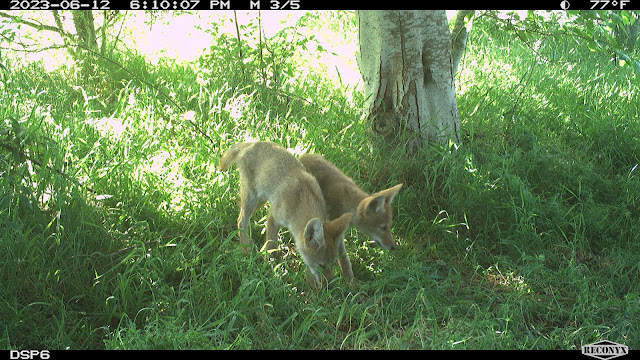Posted by Katie Remine, Living Northwest Conservation Manager and Brianna Widner, Community Science Specialist
Photos: Woodland Park Zoo motion-triggered wildlife cameras
 |
| Coyote pups as seen from one of Woodland Park Zoo's motion-triggered cameras |
When was the last time you saw a wild mammal larger than a squirrel in the city? Mammals are less studied in urban environments than are many other species—they are often more difficult to find, observe and investigate than plants and birds, for example. The Seattle Urban Carnivore Project, launched by Woodland Park Zoo and Seattle University in 2019, uses camera traps—motion-triggered wildlife cameras—as a strategy for collecting important data on urban mammal diversity. With cameras deployed at about 45 locations across King and Kitsap counties, the project relies on the collaboration of our Seattle University partners—including undergraduate biology students—and a group of more than 100 community volunteers to manage the camera stations. (Sign up here to receive information about volunteering for our 2024 season!) We also collect data through public observations submitted via our Carnivore Spotter reporting tool.
 |
| Black bears as seen from one of Woodland Park Zoo's motion-triggered cameras |
Staff and volunteers work together to identify wild animals in the camera trap photos, translating them into analyzable data so that we can use those data to help us better understand urban carnivores and how we can coexist with them. We have already contributed our completed dataset from 2019 and 2020 to several national studies.
 |
| A bobcat as seen from one of Woodland Park Zoo's motion-triggered cameras |
.JPG) |
| A coyote (with photo-bomb on left from a mule deer) as seen from one of Woodland Park Zoo's motion-triggered cameras |
 |
| A barred owl as seen from one of Woodland Park Zoo's motion-triggered cameras |
 |
| The motion-triggered cameras work in all levels of light, as evidenced by this nighttime bobcat pic. |
 |
| This raccoon (that appears to be "holding up" the branch of a tree) is a common nighttime visitor. |
The Seattle Urban Carnivore Project leverages the deeper understanding of urban carnivores we’re gaining from our research to support coexistence, ensuring that both people and wildlife can survive and thrive in the region. To this end, we recently collaborated with Washington Department of Fish and Wildlife – with input and support from the Snoqualmie Tribe’s Tribal Culture, Environmental, and Ancestral Lands Movement teams—to develop new posters and social media toolkits to help community members collaboratively coexist with wildlife. The posters are presented in English and five non-English languages, plus a version that includes Lushootseed animal names. Posters are available for download and printing on our website at www.zoo.org/coexisting and will be displayed in parks and neighborhoods around King County as well as on Snoqualmie Tribe Ancestral Lands. Jaime Martin, Executive Director of Special Projects and Governmental Affairs for the Snoqualmie Tribe, emphasizes that “it is important to the Tribe that the animals whose homes are impacted by human activities, including recreation, are respected.”
.png) |
| Coexistence poster with animal names in Lushootseed language |
.png) |
| Coexistence poster in Spanish |
“Living near wildlife is one of the amazing things about Washington, including the Seattle area,” said Chris Anderson, King County district wildlife biologist for the Washington Department of Fish and Wildlife. “We all have a responsibility to reduce the potential for conflicts with wild animals, whether by securing your garbage or maintaining a safe distance from wildlife. The Zoo’s new WILDLIFE LIVE HERE toolkit will be a great resource for outreach to local communities.”
We invite you to print and display a coexistence poster in your neighborhood or share a message from one of the toolkits on social media. These actions will be most effective if we all work together. Please work with your neighbors to help your community coexist with coyotes!
References:
Haight, J.D., Hall, S.J., Fidino, M. et al. Urbanization, climate and species traits shape mammal communities from local to continental scales. Nat Ecol Evol (2023). https://doi.org/10.1038/s41559-023-02166-x
Liu, J. Warming amplifies urbanization effects on mammals. Nat Ecol Evol 7, 1585–1586 (2023). https://doi.org/10.1038/s41559-023-02164-z
Comments
Post a Comment